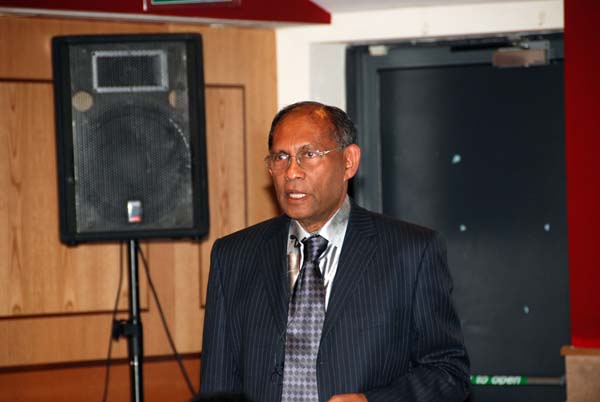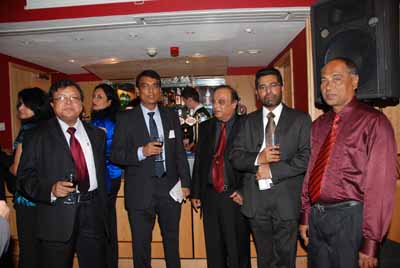CHANDRA WICKRAMASINGHE SAYS
MICROBIAL LIFE IS EVIDENT IN THE UPPER CLOUDS OF PLANET VENUS
By Walter Jayawardhana
 Professor
Chandra Wickramasinghe photos by Sisira Maddumage Professor
Chandra Wickramasinghe photos by Sisira Maddumage
The Planet Venus, as hot as hell and written off as a habitat of any
life in recent times could be, after all harbouring microbial life in
its cloudy upper atmosphere.
Professor Chandra Wickramasinghe of Cardiff University, the world’s
leading authority of the theory of “Panspermia” that says
life on earth originated in deep space and travelled here hitch hiking
on comets, said “according to the latest researches of me any my
daughter Janaki Wickramasinghe the planet Venus has a microbial ecology
high in its atmosphere.”
He was delivering the keynote address at the Annual General meeting
of the Association of Professional Sri Lankans in the United Kingdom
at Baylis House, in Slough, England. President of the Association, Dr.
Andrew Nayagam presided.
“Every 580 days when the Sun, Venus and Earth are in a line,”
said Professor Wickramasinghe, “microbes from Venus can be transferred
to Earth. The planets Venus, Earth, Mars are surely interconnected biologically
and Life on Earth represents a connected chain of being that extends
to the remotest corners of the cosmos.”
The second rocky planet from the sun and for its earth like size, for
a long time the bright “morning star” Venus had been talked
about as sister planet of earth and the habitat of not microbial but
evolved intelligent life, some time ago. Earth is the next-door neighbour
of Venus.
In 1686 a French "man of letters", Bernard de Fontenelle,
wrote that the inhabitants of Venus resembled the Moors of Granada;
a small black people, burned by the sun, full of wit and fire, always
in love, writing verse, fond of music…..”
But after 1960’s scientists surely came to know the surface of
the planet with lead melting heat does not resemble earth at all and
is always covered with a thick layer of clouds of sulphuric acid droplets.
But according to the latest researches, it is a different story. On
the top layer of the clouds, and according to Professor Wickramasinghe,
it could harbour microbial life.
Wickramasinghe said, until the 1970’s the prevailing view in science
was that life began on the Earth in a “warm little pond”.
Haldane, Oparin, Urey, Miller, Ponnamperuma were amongst those who supported
this viewpoint, and a great deal of effort was directed towards trying
to demonstrate this in the laboratory. No significant successes have
been reported so far, he said.
In the late 1970’s and early 1980’s the idea that life is
a truly cosmic phenomenon was championed by the late Sir Fred Hoyle
and Chandra Wickramasinghe. These ideas were intensely controversial
at the time, but over the last 2 decades the Hoyle-Wickramasinghe model
has been vindicated by all the space missions and laboratory discoveries
that have taken place.
Life is harboured in comets (there are about 100 billion comets around
our planetary system) and the injection of comet-borne bacteria introduced
life to Earth and to every other habitable planet, according to the
theory of Chandra Wickramasinghe. He said comets brought to earth not
only life but all the life sustaining water in earth’s oceans.
He said the Oort Cloud, at the farthest reaches of the solar system
from where the spectacular comets originate indicate it consists of
organic matter. He said microbial life could not only travel from the
farthest reaches of the universe but also from planet to planet.
At the conjunction of planets , when earth, venus and sun come to one
line he said 1 to 10 grams of bacteria is transferred from venus to
earth. He said this kind of transfers could be of matter consisting
of primitive life but also of evolved life. He said Methane found on
Mars could be related to life material.
Further addressing the Association of Professional Sri Lankans in the
UK, Professor Chandra Wickramasinghe said, “From time immemorial
our ancestors have gazed at the night sky, the Milky Way comprised of
billions of suns and wondered how we humans fit into this grand scheme
of things.
When he grew up in Colombo and the city’s atmosphere was less
polluted he could recall the finest view of the canopy of stars he enjoyed.
Early depictions of constellations can be seen in primitive cave paintings
that go back nearly 15,000 years.
Well formulated ideas about the Universe, however, can be traced back
to ancient Greece in the 5th century BC. Plato and Aristotle favoured
a world view where the Earth was at the centre of the Universe. Despite
a few dissenters, notably Aristarchus of Samos, the Geocentric model
prevailed in Western philosophy until the 16th century AD, when Copernicus,
Galileo and Newton finally demoted the Earth to the position of a planet
orbiting around the Sun.
Likewise the idea that life is Earth-centred and that living organisms
are created spontaneously from inorganic matter prevailed in Western
philosophy from the time of Aristotle, who supposed that “fireflies
emerge from a mixture of warm earth and morning dew” The origin
of life has been a problem first tackled by religion, then by philosophy
and finally by science.
He said life is a cosmic phenomenon and spread out throughout the whole
universe. He said, answering questions, that even intelligence, superior
to that of the humans of the evolutionary scale ,probably could be found
elsewhere in the universe.
Answering why it has not been found so far, he said we have been looking
for life only for the last fifty years, starting projects like SETI
and it is too short a period to find out life in this vast universe,
by trying to listen to artificial radio waves.

Members of the Professional Sri Lankans in the United Kingdom -photos
by Sisira Maddumage
|
 Professor
Chandra Wickramasinghe photos by Sisira Maddumage
Professor
Chandra Wickramasinghe photos by Sisira Maddumage